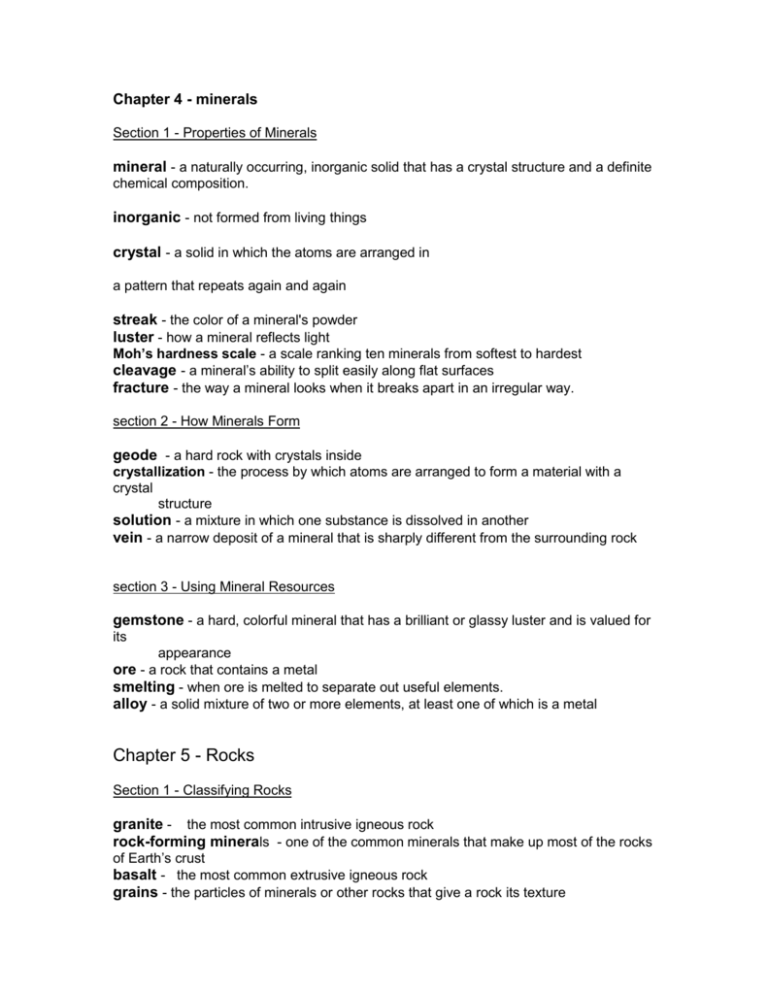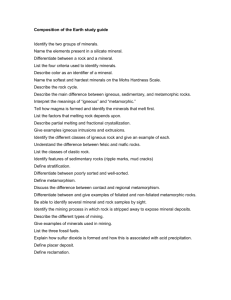Chapter 4 - minerals - Kenston Local Schools
advertisement

Chapter 4 - minerals Section 1 - Properties of Minerals mineral - a naturally occurring, inorganic solid that has a crystal structure and a definite chemical composition. inorganic - not formed from living things crystal - a solid in which the atoms are arranged in a pattern that repeats again and again streak - the color of a mineral's powder luster - how a mineral reflects light Moh’s hardness scale - a scale ranking ten minerals from softest to hardest cleavage - a mineral’s ability to split easily along flat surfaces fracture - the way a mineral looks when it breaks apart in an irregular way. section 2 - How Minerals Form geode - a hard rock with crystals inside crystallization - the process by which atoms are arranged to form a material with a crystal structure solution - a mixture in which one substance is dissolved in another vein - a narrow deposit of a mineral that is sharply different from the surrounding rock section 3 - Using Mineral Resources gemstone - a hard, colorful mineral that has a brilliant or glassy luster and is valued for its appearance ore - a rock that contains a metal smelting - when ore is melted to separate out useful elements. alloy - a solid mixture of two or more elements, at least one of which is a metal Chapter 5 - Rocks Section 1 - Classifying Rocks granite - the most common intrusive igneous rock rock-forming minerals - one of the common minerals that make up most of the rocks of Earth’s crust basalt - the most common extrusive igneous rock grains - the particles of minerals or other rocks that give a rock its texture texture -the look and feel of a rock’s surface igneous rock - a type of rock that forms from the cooling of molten rock at or below the surface. sedimentary rock - a type of rock that forms when particles from other rocks or the remains of plants and animals are pressed and cemented together metamorphic rock - a type of rock that forms from an existing rock that is changed by heat, pressure, or chemical reactions. (examples: slate, marble, quartzite) Section 2 - Igneous Rock extrusive rock - igneous rock that forms from lava on the Earth's surface intrusive rock - igneous rock that forms when magma hardens beneath Earth's surface. section 3 - Sedimentary Rock sediment - small, solid pieces of material that come from rocks or organisms erosion - the destructive process in which water or wind loosens and carries away fragments of rock deposition - the process by which sediment settles out of the water or wind that is carrying it compaction - the process that presses sediment together cementation - the process by which dissolved minerals crystallize and glue particles of sediment together into one mass clastic rock - sedimentary rock that forms when rock fragments are squeezed together under high pressure organic rock - sedimentary rock that forms from remains of organisms deposited in thick layers chemical rock - sedimentary rock that forms when minerals crystallize from a solution section 4 Rocks from Reefs coral reef - A structure of calcite skeletons built up by coral animals in warm, shallow ocean water. Section 5 - Metamorphic Rocks foliated - when metamorphic rocks have grains arranged in parallel layers or bands. Section 6 - the rock cycle rock cycle - A series of processes on the surface and inside the earth that slowly changes rocks from one kind to another.





